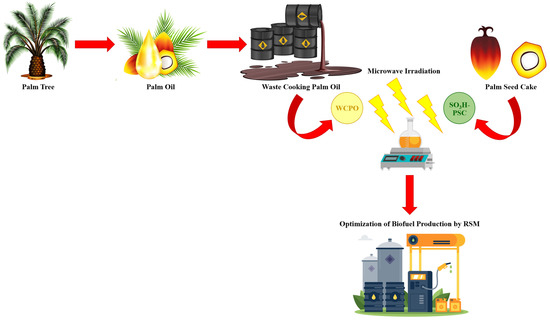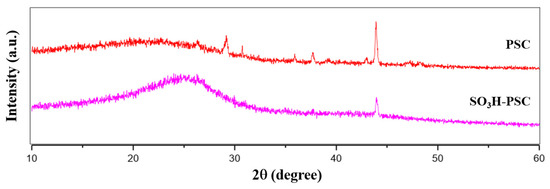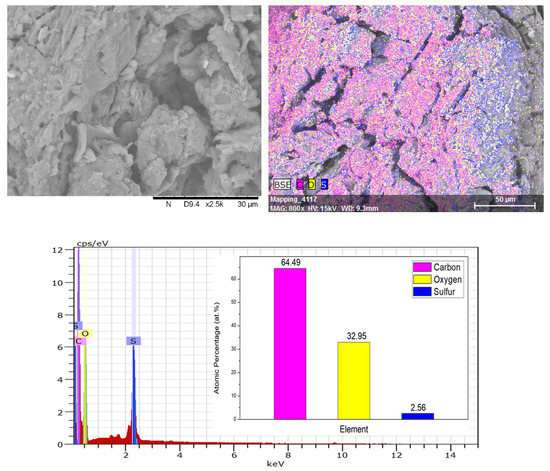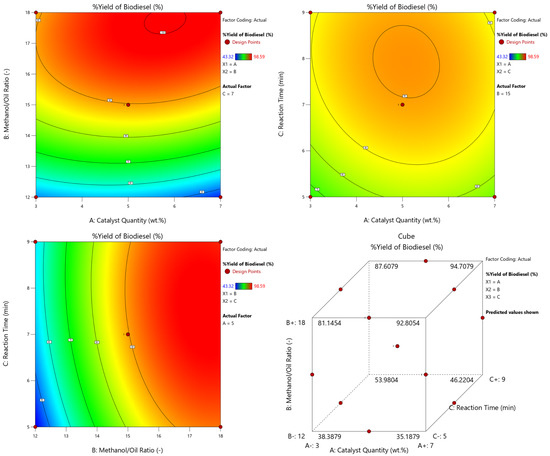Abstract
This research studied the synthesis of green and novel catalysts from waste materials for biodiesel production. An activated carbon (AC) material from palm seed cake (PSC) was soaked with zine chloride (ZnCl2) and treated with sulfonic acid (SO3H). The use of a sulfonated palm seed cake (SO3H-PSC)-derived catalyst for the transesterification/esterification of triglyceride (TG) in waste cooking palm oil (WCPO) was demonstrated. The synthesized SO3H-PSC catalyst was characterized using powder X-ray diffraction (XRD), Fourier transform infrared spectrometer (FTIR), scanning electron microscopy (SEM), energy-dispersive spectrometry (EDS), and the Brunauer–Emmet–Teller (BET) method. To study the effects of methanol/oil mole ratio, amount of catalyst, and reaction time, the process of biodiesel production in a microwave reactor was optimized using a Box-Behnken design (BBD) approach with response surface methodology (RSM). As a result, the optimum reaction parameters found were 5.40 wt.% of the SO3H-PSC catalyst, 17.35:1 methanol/WCPO mole ratio, and 8.57 min of reaction time. The synthesized biodiesel from WCPO meets the criteria for standard biodiesel (ASTM D-6751 and EN 14214). The heterogeneous catalyst demonstrates a promising and effective application for the biodiesel process, especially for feedstocks containing high free fatty acid (FFA) content.
1. Introduction
Due to population growth and accelerated industrial development, the demand for fossil fuels has increased despite their negative environmental impact. This situation has prompted the search for environmentally friendly and sustainable alternative energy sources [1]. Recently, biodiesel has become more popular due to its environmental benefits and the fact that it is derived from renewable resources. The transesterification/esterification of triglyceride (TG) in vegetable oils with methanol (CH3OH) or ethanol (C2H5OH), as well as the principal applications of the fatty acid methyl esters (FAMEs) or fatty acid ethyl esters (FAEEs), are discussed in the literature [2,3]. The procedure can be catalyzed chemically or enzymatically, and it can also be performed under supercritical circumstances without the use of a catalyst. The typical catalysts for this method are consistent strong bases or acids. Because of environmental constraints and process simplifications, homogeneous catalysts will be mostly substituted by heterogeneous catalysts in the near future [4].
A variety of substrates have been used to prepare heterogeneous catalysts for biofuel synthesis. However, many noted drawbacks to using these catalysts, including higher biofuel production costs, intensive reaction conditions, and poor reusability. Alternatively, in recent years, biomass-based support materials have acquired popularity due to their cheap cost and minimal environmental impact during heterogeneous catalyst production. Here, carbon derived from biomass, also known as activated carbon (AC), has acquired popularity due to its many desirable physiochemical properties, wide supply, and low cost [5]. Because of their chemical inertness and excellent mechanical and thermal stability, carbon-based solid acids are viewed as perfect catalysts for many reactions. Carbon structures, whether aromatic or cyclic, abundant in the oxygenated functional group are thought to be present in the solid catalyst produced from a material with high levels of lignin and carbohydrates [6].
Palm oil is derived from the fruit of the oil palm tree. Oil palm mills produce a significant amount of both liquid and solid waste. Given the significant quantities of solid waste generated by oil palm mills, there is a need for their recovery and/or recycling. These wastes are presently either disposed of in landfills or burned for energy production [7]. The goal of this study was to develop a method for making a solid acid catalyst from organic refuse products commonly found in Thailand factories, especially palm seed cake (PSC). To enhance working factors, the response surface method (RSM) is applied. It is used to assess many components and their interactions, as well as to reduce the number of required experimental trials in order to speed up and correctly carry out the experimental process. The Box-Behnken design (BBD) is one of many available designs at RSM that have been widely used to improve the biodiesel process. This is because BBD can predict, is more effective at parameter tuning, and requires fewer trials than other systems.
2. Materials and Methods
The PSC was gained from Absolute Palm Co., Ltd., Bangkok, Thailand. The waste cooking palm oil (WCPO) feedstock containing high free fatty acid (FFA) content was obtained for free from several restaurants in the surrounding area of Silpakorn University in Nakhon Pathom, Thailand. It was first filtered to eliminate impurities before being heated in an oven at 100 °C for 30 min to remove any residual wetness. Zine chloride (ZnCl2), sulfonic acid (SO3H), and methanol were analytical grade chemicals (Merck Ltd., Bangkok, Thailand, greater than 99% purity) that were used precisely as received.
In brief, after pyrolysis of soaked PSC with ZnCl2, the PSC-based acidic catalyst was developed via a sulfonation process. A previous method [8] for preparing the sulfonated palm seed cake (SO3H-PSC) derived catalyst was followed and slightly modified. Powder X-ray diffraction (XRD), Fourier transform infrared spectroscopy (FTIR), scanning electron microscopy (SEM), energy-dispersive spectroscopy (EDS), and the Brunauer–Emmet–Teller (BET) technique were used to characterize the novel catalyst.
By applying BBD of RSM, the effect of reaction parameters such as catalyst quantity (3–7 wt.%), methanol/WCPO mole ratio (12–18), and reaction time (5–9 min) on %yield of FAME (biodiesel) was examined. Each test was performed 3 times, and the standard deviation at any given point never exceeded 7%. A quadratic polynomial equation was generated utilizing Design-Expert® Software, version 13 (Stat-Ease, Inc., Minneapolis, MN, USA). The analysis of variance (ANOVA) test was employed to evaluate the model’s fit [9]. Using gas chromatography–mass spectrometry (GC-MS), the biodiesel’s composition was identified. The catalyst quantity (A), methanol/WCPO mole ratio (B), and reaction time (C) were the three independent factors in a three-variable BBD that was optimized through 15 experiments. Table 1 displays the three independent variables’ actual amounts in coded values. Figure 1 depicts the RSM process for producing biodiesel using SO3H-PSC catalysts from WCPO and methanol in a microwave reactor.

Table 1.
Factors and levels of RSM process for biodiesel production.

Figure 1.
Scheme of the production of biodiesel from WCPO and methanol using the SO3H-PSC catalyst with a microwave reactor.
3. Results and Discussion
Figure 2 depicts the XRD patterns of the PSC and SO3H-PSC catalysts. The samples showed one broad and one weak peak at 2θ = 10–30° and 2θ = 40–50°, corresponding to C (0 0 2) and C (1 0 1), respectively. The broad peaks around 2θ = 10–30° are a typical feature of amorphous carbon, which includes aromatic carbon sheets. Meanwhile, the sharp peak is ascribed to graphite’s crystalline three-dimensional region [6].

Figure 2.
XRD patterns of PSC and SO3H-PSC samples.
The FTIR spectra of the PSC and SO3H-PSC samples are displayed in Figure 3. The FTIR transmission at 1195 cm−1 for –SO2 asymmetric stretching and 1050 cm−1 for –SO2 symmetric stretching can detect the presence of sulfonic groups (–SO3H). Rashid et al. [5] reported almost identical outcomes for a sulfonated carbon catalyst derived from residual carbohydrates.

Figure 3.
FTIR spectra of PSC and SO3H-PSC samples.
Figure 4 represents the SEM image of a sample of SO3H-PSC. The particles of the catalyst were agglomerated and irregular. After soaking in ZnCl2 and sulfonation with SO3H, the surface texture of the raw material was drastically altered [8]. Furthermore, Figure 4 shows the EDS spectrum and the elemental composition of the SO3H-PSC catalyst. With atomic percent values of 64.49, 32.95, and 2.56, respectively, carbon (C), oxygen (O), and sulfur (S) were evidently the primary components of the solid catalyst. During the modification process, the acid content would be deposited on the catalyst’s surface as opposed to the catalyst pores.

Figure 4.
SEM image and EDS analysis of SO3H-PSC sample.
The SO3H-PSC catalyst had a pore volume of 0.32 cm3/g and a BET surface area of 14.83 m2/g. The substantial decrease in the BET surface area of the catalyst indicates that acid molecules (SO3H groups) have occupied the AC’s pores, supporting the previously stated concept [10]. Furthermore, it is evident that the catalyst substantially increased the number of active sites.
They found that increasing the reaction time from 5 to 9 min at the methanol/WCPO mole ratios of 12:1 to 18:1 resulted in a higher percentage output of biodiesel (FAME). Furthermore, when the catalyst quantity exceeds the optimal value of 5 wt.%, the percentage of biodiesel yield decreases [11]. The contour plots in Figure 5 are an excellent visual representation of this study. The cubical representation of the parameters demonstrates how each parameter affects the biodiesel output in percentage terms. Analyzing the order in which these factors appear also aids [12]. The optimal operating parameters for achieving 98.92% biodiesel yield are a catalyst quantity of 5.40 wt.%, a methanol/WCPO mole ratio of 17.35:1, and a reaction time of 8.57 min. According to the GC-MS characterization report, WCPO is a great feedstock for the manufacturing of biofuel.

Figure 5.
Optimal reaction conditions by contour plots of the catalyst quantity, methanol/oil ratio and reaction time, and cubical representation of effects of various parameters on %yield of biodiesel.
The fuel properties of biodiesel obtained in this study, such as kinematic viscosity, density, flash point, cloud point, pour point, acid value, and moisture content, satisfy the requirements for standard biodiesel (ASTM D-6751 and EN 14214). The majority of its properties fall within the range of fuel properties specified in the most recent biodiesel standards [13].
4. Conclusions
In this investigation, the synthesis of SO3H-PSC catalysts for biodiesel production was demonstrated. The novel catalyst was successfully applied to highly acidic WCPO, which yielded approximately 98% biodiesel. The RSM algorithm was utilized to validate the optimal yield outcomes.
Supplementary Materials
The presentation materials can be downloaded at: https://www.mdpi.com/article/10.3390/ECP2023-14666/s1.
Author Contributions
The present work was produced through a collaborative effort involving all of the authors. A.B. was responsible for the conceptualization of the experiments, data analysis, and the initial drafting of the manuscript, which was subsequently revised thoroughly. The experiments in the laboratory were conducted by P.S., S.P. and O.B.; V.L. made contributions to the conceptual approach and results discussion and provided approval for the final version of the revised manuscript. All authors have read and agreed to the published version of the manuscript.
Funding
This research did not receive any specific grant from funding agencies in the public, commercial, or not-for-profit sectors.
Institutional Review Board Statement
Not applicable.
Informed Consent Statement
Not applicable.
Data Availability Statement
Not applicable.
Acknowledgments
The authors would also like to express their appreciation to the Department of Materials Science and Engineering, Faculty of Engineering and Industrial Technology at Silpakorn University for their assistance and support with this undertaking.
Conflicts of Interest
The authors declare no conflict of interest.
References
- Ngomade, S.B.L.; Tchuifon, R.D.T.; Tagne, R.F.T.; Ngueteu, M.L.T.; Patai, H.M.; Nche, G.N.-A.; Anagho, S.G. Optimization by response surface methodology of biodiesel production from Podocarpus falcatus oil as a Cameroonian novel nonedible feedstock. J. Chem. 2022, 2022, 3786602. [Google Scholar] [CrossRef]
- Kolakoti, A.; Jha, P.; Mosa, P.R.; Mahapatro, M.; Kotaru, T.G. Optimization and modelling of mahua oil biodiesel using RSM and genetic algorithm techniques. MME 2020, 6, 134–146. [Google Scholar] [CrossRef]
- Silva, G.F.; Camargo, F.L.; Ferreira, A.L.O. Application of response surface methodology for optimization of biodiesel production by transesterification of soybean oil with ethanol. Fuel Process. Technol. 2011, 92, 407–413. [Google Scholar] [CrossRef]
- Buasri, A.; Loryuenyong, V. The new green catalysts derived from waste razor and surf clam shells for biodiesel production in a continuous reactor. Green Process. Synth. 2015, 4, 389–397. [Google Scholar] [CrossRef]
- Rashid, U.; Ahmad, J.; Ibrahim, M.L.; Nisar, J.; Hanif, M.A.; Shean, T.Y.C. Single-pot synthesis of biodiesel using efficient sulfonated-derived tea waste-heterogeneous catalyst. Materials 2019, 12, 2293. [Google Scholar] [CrossRef] [PubMed]
- Farabi, M.S.A.; Ibrahim, M.L.; Rashid, U.; Taufiq-Yap, Y.H. Esterification of palm fatty acid distillate using sulfonated carbon-based catalyst derived from palm kernel shell and bamboo. Energy Convers. Manag. 2019, 181, 562–570. [Google Scholar] [CrossRef]
- Bazargan, A.; Kostić, M.D.; Stamenković, O.S.; Veljković, V.B.; McKay, G. A calcium oxide-based catalyst derived from palm kernel shell gasification residues for biodiesel production. Fuel 2015, 150, 519–525. [Google Scholar] [CrossRef]
- Akinfalabi, S.-I.; Rashid, U.; Yunus, R.; Taufiq-Yap, Y.H. Synthesis of biodiesel from palm fatty acid distillate using sulfonated palm seed cake catalyst. Renew. Energ. 2017, 111, 611–619. [Google Scholar] [CrossRef]
- Balajii, M.; Niju, S. A novel biobased heterogeneous catalyst derived from Musa acuminata peduncle for biodiesel production—Process optimization using central composite design. Energy Convers. Manag. 2019, 189, 118–131. [Google Scholar] [CrossRef]
- Buasri, A.; Loryuenyong, V. Continuous production of biodiesel from rubber seed oil using a packed bed reactor with BaCl2 impregnated CaO as catalyst. Bull. Chem. React. Eng. Catal. 2018, 13, 320–330. [Google Scholar] [CrossRef]
- Ngige, G.A.; Ovuoraye, P.E.; Igwegbe, C.A.; Fetahi, E.; Okeke, J.A.; Yakubu, A.D.; Onyechi, P.C. RSM optimization and yield prediction for biodiesel produced from alkali-catalytic transesterification of pawpaw seed extract: Thermodynamics, kinetics, and multiple linear regression analysis. Digit. Chem. Eng. 2023, 6, 100066. [Google Scholar] [CrossRef]
- Kumar, P.; Kumar, N. Process optimization for production of biodiesel from orange peel oil using response surface methodology. Energ. Source. Part A 2021, 43, 727–737. [Google Scholar] [CrossRef]
- Buasri, A.; Lukkanasiri, M.; Nernrimnong, R.; Tonseeya, S.; Rochanakit, K.; Wongvitvichot, W.; Masa-ard, U.; Loryuenyong, V. Rapid transesterification of Jatropha curcas oil to biodiesel using novel catalyst with a microwave heating system. Korean J. Chem. Eng. 2016, 33, 3388–3400. [Google Scholar] [CrossRef]
Disclaimer/Publisher’s Note: The statements, opinions and data contained in all publications are solely those of the individual author(s) and contributor(s) and not of MDPI and/or the editor(s). MDPI and/or the editor(s) disclaim responsibility for any injury to people or property resulting from any ideas, methods, instructions or products referred to in the content. |
© 2023 by the authors. Licensee MDPI, Basel, Switzerland. This article is an open access article distributed under the terms and conditions of the Creative Commons Attribution (CC BY) license (https://creativecommons.org/licenses/by/4.0/).